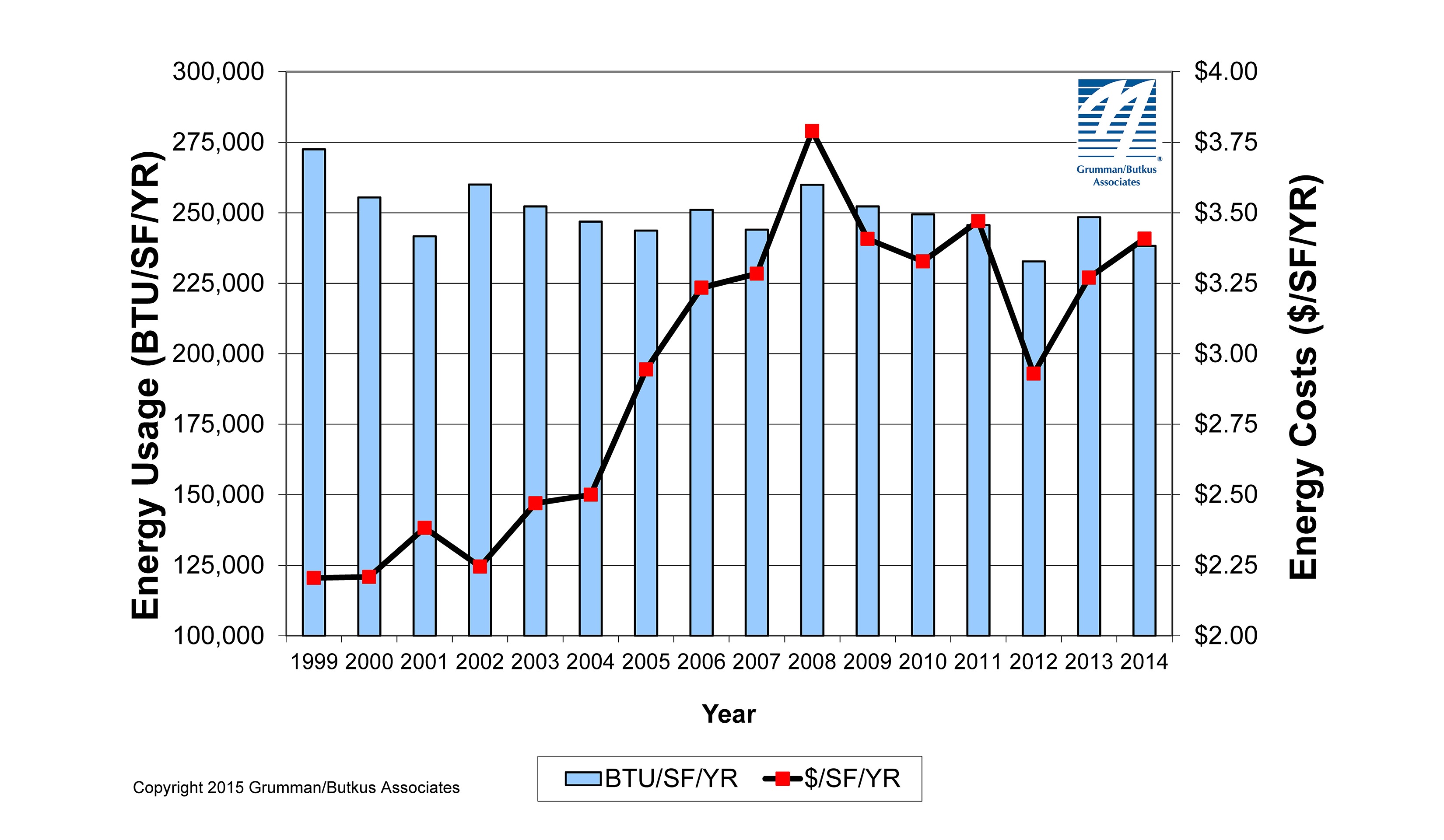Grumman/Butkus Associates, a firm of energy efficiency consultants and sustainable design engineers, has released the results of its 2015 Hospital Energy and Water Benchmarking Survey, focusing on healthcare facilities’ resource usage trends and costs for calendar year 2014.
Since the survey was initiated 20 years ago, hospitals’ overall fossil fuel use has trended downward, but electricity use isn’t declining much. The average combined Btu/sf for facilities in the survey (electricity plus gas/steam) was 232,981 in CY2014, compared with 248,456 in the 2014 survey (CY2013). Harsher winter temperatures in 2012-13 compared with 2013-14 likely had something to do with the usage decline.
Square-foot prices for gas/steam were up year-to-year ($1.01 in 2013, vs. $1.16 in 2013), but square-foot prices for electricity fell ($2.26 in 2013 vs. $2.12 in 2014). The overall result of these usage and pricing patterns was that hospitals’ total sf costs for energy (gas/steam plus electric) hardly changed: $3.29 in CY2014, vs. $3.27 in CY2013.
Carbon footprint results have stayed fairly steady over time, at about 60 pounds of CO2 equivalent per ft2 per year, but have been slowly trending downward since 2010.
Reporting facilities displayed a range of usage patterns. For instance, some participants are using more than 200,000 BTU/ft2 in fossil fuel annually, compared with a general mid range of facilities (about 150,000 BTU/sf/year) and those that used least (100,000 BTU/sf/year). Similarly, a few hospitals consume more than 40 kWh/sf/year in electricity, compared with a mid-range of about 25 kWh/sf/year. A few squeaked by with less than 20 kWh/ft2.
“Hospitals are investing in efficiency measures and making progress, but have much further to go,” says G/BA Chairman Daniel L. Doyle. “Some of the low-hanging fruit is gone, but there are still many cost-effective opportunities remaining for reducing energy usage and costs.”
Hospital water use is also gradually declining, currently averaging about 49 gallons per square foot per year (compared with nearly 70 gallons/sf/year a decade ago). Costs per gallon are rising, however, now averaging $0.38/sf. As recently as 2007, hospitals were paying just $0.27/sf.
“The downward usage trend reflects a movement to eliminate city-water-cooled equipment, as well as the increased use of low-flow and occupancy-based plumbing fixtures,” says Doyle. “Water usage is an emerging issue. There is still much room for improvement.”
The G/BA survey has provided a free annual benchmarking resource since its initial release in 1995. Hospitals are invited to participate without charge by submitting responses to a short list of questions. Information for this edition was provided by 117 hospitals located in Illinois (56), Wisconsin (33), Michigan (5), Indiana (5), and seven other states.
Full results and analysis, as well as information about participating in the 2015 survey, are available at the firm’s website. For additional information, contact Doyle (ddoyle@grummanbutkus.com) or Julie Higginbotham (jhigginbotham@grummanbutkus.com).
Related Stories
M/E/P Systems | Oct 30, 2024
After residential success, DOE will test heat pumps for cold climates in commercial sector
All eight manufacturers in the U.S. Department of Energy’s Residential Cold Climate Heat Pump Challenge completed rigorous product field testing to demonstrate energy efficiency and improved performance in cold weather.
MFPRO+ New Projects | Oct 30, 2024
Luxury waterfront tower in Brooklyn features East River and Manhattan skyline views
Leasing recently began for The Dupont, a 41-story luxury rental property along the Brooklyn, N.Y., waterfront. Located within the 22-acre Greenpoint Landing, where it overlooks the newly constructed Newtown Barge Park, the high-rise features East River and Manhattan skyline views along with 20,000 sf of indoor and outdoor communal space.
Resiliency | Oct 29, 2024
Climate change degrades buildings slowly but steadily
While natural disasters such as hurricanes and wildfires can destroy buildings in minutes, other factors exacerbated by climate change degrade buildings more slowly but still cause costly damage.
Office Buildings | Oct 29, 2024
Editorial call for Office Building project case studies
BD+C editors are looking to feature a roundup of office building projects for 2024, including office-to-residential conversions. Deadline for submission: December 6, 2024.
Healthcare Facilities | Oct 28, 2024
New surgical tower is largest addition to UNC Health campus in Chapel Hill
Construction on UNC Health’s North Carolina Surgical Hospital, the largest addition to the Chapel Hill campus since it was built in 1952, was recently completed. The seven-story, 375,000-sf structure houses 26 operating rooms, four of which are hybrid size to accommodate additional equipment and technology for newly developed procedures.
Sports and Recreational Facilities | Oct 24, 2024
Stadium renovation plans unveiled for Boston’s National Women’s Soccer League
A city-owned 75-year-old stadium in Boston’s historic Franklin Park will be renovated for a new National Women’s Soccer League team. The park, designed by Fredrick Law Olmsted in the 1880s, is the home of White Stadium, which was built in 1949 and has since fallen into disrepair.
Laboratories | Oct 23, 2024
From sterile to stimulating: The rise of community-centric life sciences campuses
To distinguish their life sciences campuses, developers are partnering with architectural and design firms to reimagine life sciences facilities as vibrant, welcoming destinations. By emphasizing four key elements—wellness, collaboration, biophilic design, and community integration—they are setting their properties apart.
Engineers | Oct 23, 2024
Navigating battery energy storage augmentation
By implementing an augmentation plan upfront, owners can minimize potential delays and unforeseen costs when augmentation needs to occur, according to Burns & McDonnell energy storage technology manager Joshua Crawford.
Adaptive Reuse | Oct 22, 2024
Adaptive reuse project transforms 1840s-era mill building into rental housing
A recently opened multifamily property in Lawrence, Mass., is an adaptive reuse of an 1840s-era mill building. Stone Mill Lofts is one of the first all-electric mixed-income multifamily properties in Massachusetts. The all-electric building meets ambitious modern energy codes and stringent National Park Service historic preservation guidelines.
MFPRO+ News | Oct 22, 2024
Project financing tempers robust demand for multifamily housing
AEC Giants with multifamily practices report that the sector has been struggling over the past year, despite the high demand for housing, especially affordable products.


















